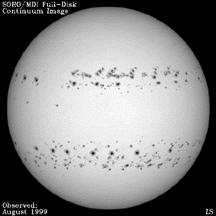What
are sun spots?
 Galileo
and other astronomers first observed dark spots on the sun
in 1610. These dark spots that they saw are now called sunspots.
Sunspots are in areas located on the surface of the sun that
are cooler than the surrounding areas. In 1843 German astronomer
Samuel Heinrich Schwabe announced that there was a pattern
to the number of sunspots he had observed. Schwabe made observations
everyday the sun was visible for seventeen years and found
that there were about ten years between the highest numbers
of sunspots he observed. It was this discovery that founded
the study of solar physics and remains the foundation for
what we call the solar cycle today. Later the rotation of
the sun was measured by observing the movements of the sunspots.
British astronomer Richard Christopher Carrington in 1859
discovered that the sun did not rotate as one body and therefore
was gaseous. In 1908 it was shown that sunspots were related
to the sun's magnetic field. This was the first time that
any object beside the Earth was shown to have a magnetic field. Galileo
and other astronomers first observed dark spots on the sun
in 1610. These dark spots that they saw are now called sunspots.
Sunspots are in areas located on the surface of the sun that
are cooler than the surrounding areas. In 1843 German astronomer
Samuel Heinrich Schwabe announced that there was a pattern
to the number of sunspots he had observed. Schwabe made observations
everyday the sun was visible for seventeen years and found
that there were about ten years between the highest numbers
of sunspots he observed. It was this discovery that founded
the study of solar physics and remains the foundation for
what we call the solar cycle today. Later the rotation of
the sun was measured by observing the movements of the sunspots.
British astronomer Richard Christopher Carrington in 1859
discovered that the sun did not rotate as one body and therefore
was gaseous. In 1908 it was shown that sunspots were related
to the sun's magnetic field. This was the first time that
any object beside the Earth was shown to have a magnetic field.
|
